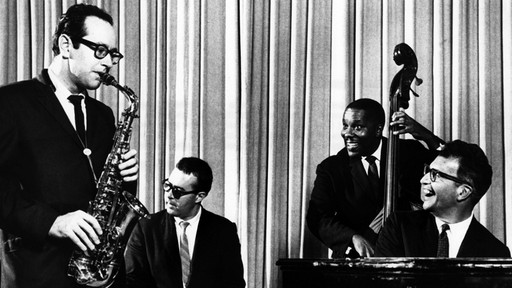It’s May 4th, which means it’s Brubeck & Desmond Day! What does the 4th of May have to do with Dave Brubeck or Paul Desmond? 5/4, of course. Brubeck and Desmond popularized and mainstreamed this unusual time signature into jazz and popular music in 1959 with Desmond’s mega hit “Take Five”, opening the door for more musical explorations in 5/4, 7/4, 9/8, and every other time signature imaginable. And so, in honor of them, every May 4th is unofficially officially Brubeck & Desmond Day (call your local senators, representatives, parliament, etc etc). On this day, we stop and reflect on the often-neglected fifth beat of music. What better way to do that than spotlight a few versions of “Take Five”? I tried to limit it to just one version of “Take Five”, but there’s so many great recordings out there that I ended up including my top three favorite versions, plus a more modern song built off of the original “Take Five” recording from 1959. Enjoy, and May the 4th be with you!
1961
Recorded in 1961 in San Francisco, California for Ralph Gleason’s television show ‘Jazz Casual’, this performance of “Take Five” has what I consider to be Paul Desmond’s tastiest “Take Five” solo on record. Mercy. Such logic. Such cohesion. Such flow. Such taste. He even manages to work a reference to the “Exodus Theme” into his solo, which is totally appropriate, considering the song… Eugene Wright and Joe Morello are on bass and drums respectively.
1964
This one’s a sleeper. And there’s a humorous backstory. Culled from a British TV appearance on the BBC’s ‘Jazz 625’, the host Steve Race introduces the tune with some observations of how the group has changed the way they play “Take Five” since they recorded the studio version. One of his observations is how they play it faster, asking the viewers to see for themselves. While it was true that almost every version of “Take Five” on record was indeed quicker than the tentative version recorded in 1959, Joe Morello seems to defiantly set markedly more languid tempo, creating a more relaxed and dreamy mood that Desmond flourishes in. So dreamy, in fact, that Desmond’s opening statements of his solo quote almost note for note his own usual opening to “Stardust” (I’ll have to do a ‘Desmond’s Quotes’ for all of these one day). Brubeck’s solo is also in a more rhapsodic vein than usual, building from a lyrically sparse intro to a lush climax, then falling back for Desmond’s restatement of the tune. This performance makes me wonder how different the tune would’ve sounded if treated as a relaxed ballad as opposed to the often-raucous set closer it usually was.
1972
Speaking of relaxed, this version of “Take Five” is the epitome of relaxed. Also groovy, and not because it was 1972. Recorded in Berlin, Germany in 1972, Alan Dawson on drums and Jack Six on bass set a downright groovy foundation for the other guys to float over. And float they do. As the YouTuber that posted the video mentioned in the description, the groove that gets set down is similar to the hypnotizing rhythm set down in John Coltrane’s rendition of “My Favorite Things”. Desmond’s choice to gently sail into a major key and stay there for his solo adds to the infectiously hypnotizing effect. I always imagine I’m sailing through the clouds at sunset during Desmond’s solo. He ends on a suggestively dark note, ushering in baritone saxophonist Gerry Mulligan’s exploratory solo. Brubeck’s own solo flirts with the major and minor tonalities for a while. Dawson’s solo is tremendous. This rendition of “Take Five” is the logical culmination of what playing the same one chord tune for over ten years will do. Groovy.
2000
Just to show how far-reaching Desmond’s tune is, here’s a track by St. Germain entitled “Rose Rouge”. St. Germain is a French artist who made some fantastic albums that blurred the lines between jazz and whatever this is. Some call it Acid Jazz, others call it House Music, but whatever you call it, I can dig it. On this track, coming from his 2000-album ‘Tourist’, St. Germain used a mixture of live musicians and sampled music from another source. The source of that sampled music? Paul Desmond’s “Take Five”. The general consensus says this a sample of the 1959 studio version, but I wonder if it could be from the 1963 Carnegie Hall version instead? Whichever version the sample comes from, that is Joe Morello’s drums, Eugene Wright’s bass, and Dave Brubeck’s piano looped and put on repeat for the duration of the song. It’s kind of cool that, like on the actual “Take Five” tune, St. Germain has his horn players improvise off of the one ‘chord’ the whole time.
Take a moment out to see and hear some of these versions of 5/4 greatness, and again, happy 5/4 Day! Brubeck and Desmond forever!